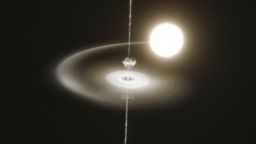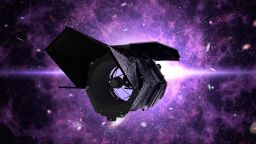Waters may be flowing on the surface of a colossal planet that lies about 120 light-years from Earth, according to new evidence uncovered by the James Webb Space Telescope.

Astronomers solve the puzzle of an unusual pulsing dead star
The investigation with the space-based observatory, one of the most advanced astronomy instruments in operation, revealed that the exoplanet K2-18b may have some key features of a planet that could support bodies of water — and life.
Closely orbiting the cool dwarf star K2-18, the exoplanet lies within the star’s habitable, or Goldilocks, zone and is 8.6 times as massive as Earth. An analysis of Webb’s observations found the planet has abundant methane and carbon dioxide in its atmosphere.
The presence of these carbon-bearing molecules, along with a scarcity of ammonia, could indicate an atmosphere rich with hydrogen that surrounds an ocean world, according to a NASA news release.
Carbon is considered the building block of life-forms on Earth.
The Hubble Space Telescope initially spotted evidence of water vapor in the exoplanet’s atmosphere. The finding, described in a September 2019 study, helped scientists home in on K2-18b for further study.
The Webb telescope, which can detect infrared light invisible to the human eye, searched for exactly what elements are featured in the planet’s atmosphere.
And the latest observations of the planet also hint that a very special molecule, called dimethyl sulfide, could be present on K2-18b.
On Earth, dimethyl sulfide “is only produced by life,” according to NASA. “The bulk of the DMS in Earth’s atmosphere is emitted from phytoplankton in marine environments.”
No guarantees
Researchers are not outright suggesting that K2-18b is crawling with alien life. Further research is needed to confirm the presence of dimethyl sulfide, said astronomer Nikku Madhusudhan, professor of astrophysics and exoplanetary science at the University of Cambridge, in a statment. Madhusudhan is lead author of a new scientific paper describing the findings that has been accepted for publication in The Astrophysical Journal Letters.
And even if scientists corroborate the chemical compound’s presence, that doesn’t guarantee life-forms exist there.
But this new evidence does expand scientists’ understanding of exoplanets similar to K2-18b.
Hot ocean worlds
The discoveries about its atmospheric composition suggest it could be a “Hycean exoplanet,” a theoretical type of exoplanet that runs hot but is covered in oceans and has a hydrogen-rich atmosphere.
Where there are liquid oceans, there is the potential for life — but researchers still aren’t certain that these Hycean planets could sustain life at all. An August study published in The Astrophysical Journal, for example, suggests they would undergo a crushing greenhouse effect.

NASA’s new telescope could spot thousands of exoplanets and hundreds of Earth-size rogue planets
There are no confirmed Hycean exoplanets just yet. And there is no planet quite like K2-18b in our own solar system, and that makes planets like it “poorly understood,” according to NASA.
The “nature of their atmospheres is a matter of active debate among astronomers,” the space agency said in a news release.
But researchers involved in analyzing these recent observations of K2-18b emphasized that continuing to unravel its mysteries is essential.
“Our ultimate goal is the identification of life on a habitable exoplanet, which would transform our understanding of our place in the universe,” Madhusudhan said. “Our findings are a promising step towards a deeper understanding of Hycean worlds in this quest.”
Researchers plan to continue using the Webb telescope to study the distant planet and attempt to further validate the new findings.
“These results are the product of just two observations of K2-18 b, with many more on the way,” said astronomer Savvas Constantinou, a doctoral student of astrophysics at the University of Cambridge who coauthored the latest study, in a statement. “This means our work here is but an early demonstration of what Webb can observe in habitable-zone exoplanets.”
(According to Jackie Wattles, CNN)

